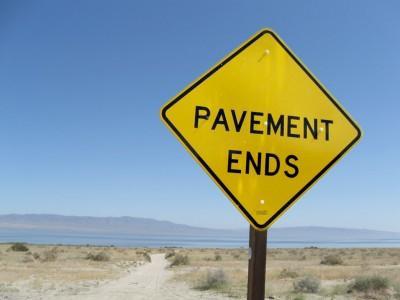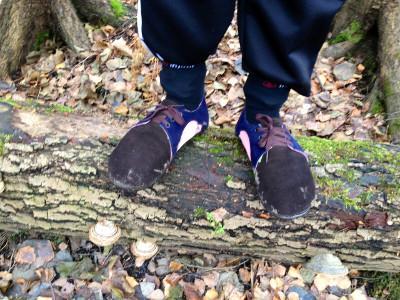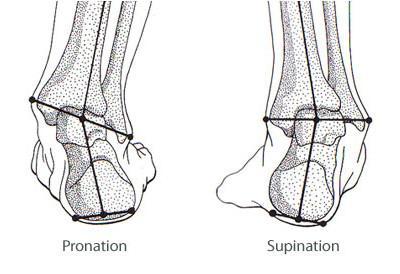
Do you wear different shoes for walking on streets than you do for walking on trails? Do you find your trail shoes are more rigid and bulky? If so, then you're not alone.
Common sense says that trails require bigger, sturdier shoes. After all, there's a whole world of twigs and rocks out there that can damage your feet and you probably want protection from them. And after spending most of the day on surfaces that are smooth and flat, how would it feel to suddenly step on a sharp rock or uneven ground? Many people believe soles should be thick and tough to block those sensations, and that the structure of the shoe should brace the ankle in an upright position. Sometimes it seems as though the whole idea of stepping on a trail implies the need for shoes that are thick, rigid and impenetrable.
The growing interest in minimalist footwear and natural foot function has shed new light on this idea. After all, our ancestors spent a lot of time on unpaved surfaces, and bulky shoes were not an option for them.

The explanation is quite simple. Walking on a flat paved surface uses the same muscles the same way for every step. Your body quickly learns how to do this, the range of motion is not challenging and there are little, if any, surprises concerning what you step upon.
On a trail, however, everything changes. Take a step off-road and your feet are now twisting every which way as they land on varied surfaces of rocks, twigs and uneven ground. This information is sent to your brain, which is then challenged to keep your body upright. At this time, it is very important for your feet to have a wide range of natural movement to adapt to surface changes. Rigid footwear not only blocks signals your feet may receive from the ground, but it can also restrict the range of motion in your feet and ankles. By inhibiting your natural foot function, you may be missing out on an opportunity to strengthen your feet while increasing the chance of injury.
For trails, the good doctors say barefoot is best, although people who have not been raised barefoot are recommended to find flexible barefoot-like shoes that allow their feet to bend and stretch naturally. And just like with minimalist running, anyone accustomed to sturdy, conventional shoes is advised to transition slowly to prevent injury; if you haven't used your muscles in this way before then they need time to strengthen and adapt.
Of course, trails do require certain needs. Most people will want some protection from those twigs and sharp rocks, and shoes that lack traction will invite slipping on loose or wet surfaces. The trick is to find shoes that have these features without restricting foot movement or weighing you down.
We're happy to share with you the original article, which includes the docs' specifications for qualities to look for in a good trail-walking shoe:
Trail Walking Footwear
(as printed in Walkabout Magazine, Issue 24)
By Ray McClanahan, DPM and Glenn Ingram, Jr., ND
Walking on blacktop or concrete is a generally predictable experience, as far as the foot and ankle are concerned. Since these surfaces are mostly flat, the numerous joints in the foot and ankle become aware of moving within limited ranges of motion.
However, the foot and ankle undergo a different, less predictable experience the moment a walker decides to go off-road. Here, these same body parts will be called upon to keep the walker upright and moving forward while simultaneously adapting to ground surfaces that at one moment will require large amounts of pronation, and in the next step require large amounts of supination.

Here is where we believe a problem exists. Many walkers are going off-road in their street shoes. And we don’t mean their dress shoes. They are often going off-road in footwear that is holding their foot in a manner that does not allow the many joints of the foot to spread out and adapt to an ever-changing ground structure.
Experiencing the full capabilities of the foot and ankle adapting to non-linear surfaces takes practice and time. It also requires wearing no footwear, or choosing footwear that does not restrict foot and ankle motion.
Unless you have grown up completely barefoot — which we are fairly certain most of you have not — then we recommend the latter. The challenge is finding appropriate shoes. Many footwear companies are capitalizing on the walking boom and making trail versions of their urban walking shoes.
The problem is that instead of making shoes that are more flexible and foot-shaped, they are making them more stiff, sturdy, and over-designed.
Off-Road Footwear Should Offer the Following:
- Protection: Ideally this should involve a covering that goes over the entire foot and is snug over the ankle to keep rocks, twigs, and other trail debris from getting into the shoe.
- Traction: Soles that are smooth will be dangerous on loose and wet surfaces. A contoured sole with ridges and grooves will generally help provide better traction. The problem here is that these materials add extra weight, which is undesirable.
- Lightweight: Footwear that is light allows the walker to respond quicker to a changing ground surface.
- Flexibility: The closer a walking shoe is to a moccasin or a slipper, the more likely that shoe’s design will allow the joints of the foot and ankle to adapt to the trail surface. Most walking shoes currently available are not flexible.
- Foot-Shaped: There are three features built into footwear that stray from the natural foot shape, and they should be avoided:
- Heel Elevation: Soles should be completely flat.
- Toespring: The ends of the toes should be flat and level with the ball of the foot.
- Tapered Toe Boxes: The space allotted to the ends of the toes should be wider than the ball of the foot.



